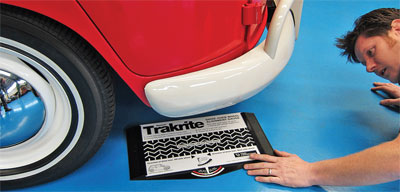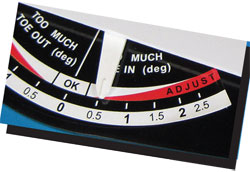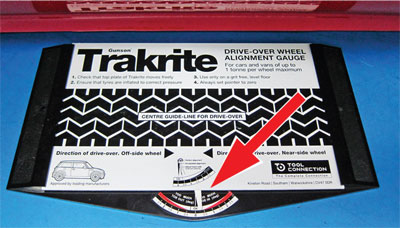Tech-TorqueYour technical guide to using Gunson tools
Contents

Gunson Trakrite Wheel Alignment Gauge
You don’t need reminding of the importance of proper wheel and suspension alignment and geometry in terms of handling, safety, and the unnecessary expense of replacing badly worn tyres, but how can you check it yourself?




The Gunson G4008 Trakrite Wheel Alignment Gauge is a simple drive-over gauge that indicates by means of a pointer if there is any sideways scrub of the tyre against the road surface, and in which way the adjustment should be made to rectify it. It is suitable both for cars and light commercial vehicles. Trakrite has a top plate which is mounted on rollers so that it is free to move sideways. As the wheel is driven over any misalignment causes the plate to be
pushed sideways - the pointer indicates on a scale the total movement of the plate and thus the amount of misalignment. After use, the pointer is reset to zero(the central position) by the user. Trakrite indicates misalignment, therefore if no deflection of the pointer takes place, the wheels are correctly aligned and require no adjustment. Carry out the wheel alignment tests on flat and level ground, preferably a clean concrete or smooth, flat asphalt surface.
First thing to do is to check that the steering is straight and settle the suspension:• Drive backwards and forwards a few times and check the vehicle is not pulling to the left or right.• Gently rock the vehicle up and down to settle the suspension.• Remove hands from steering wheel and drive forwards 2 or 3 metres.• Place the Trakrite on the ground in front of either of the vehicle’s front wheels. Make sure pointer is set to zero.• Slowly drive over Trakrite, not holding the steering wheel, until the wheel completely passes over the Trakrite, then stop. Note the amount of misalignment from the position of the pointer on the scale.• Repeat the test using the opposite front wheel to confirm the result obtained, remembering to zero the pointer before the test.• A consistent reading in the red band indicates unsatisfactory wheel alignment.
In this test the steering was toeing-in by about half a degree.


